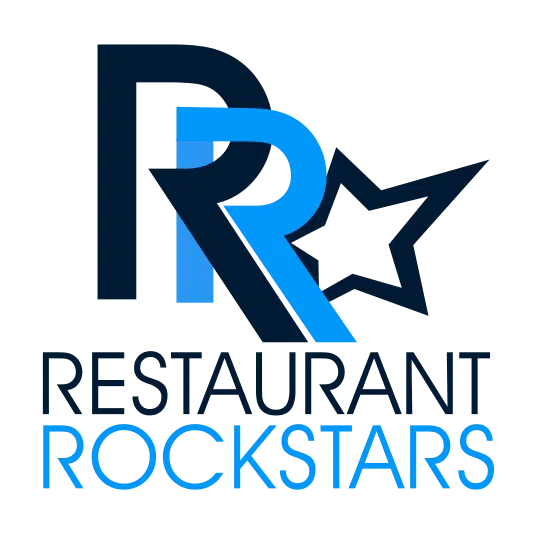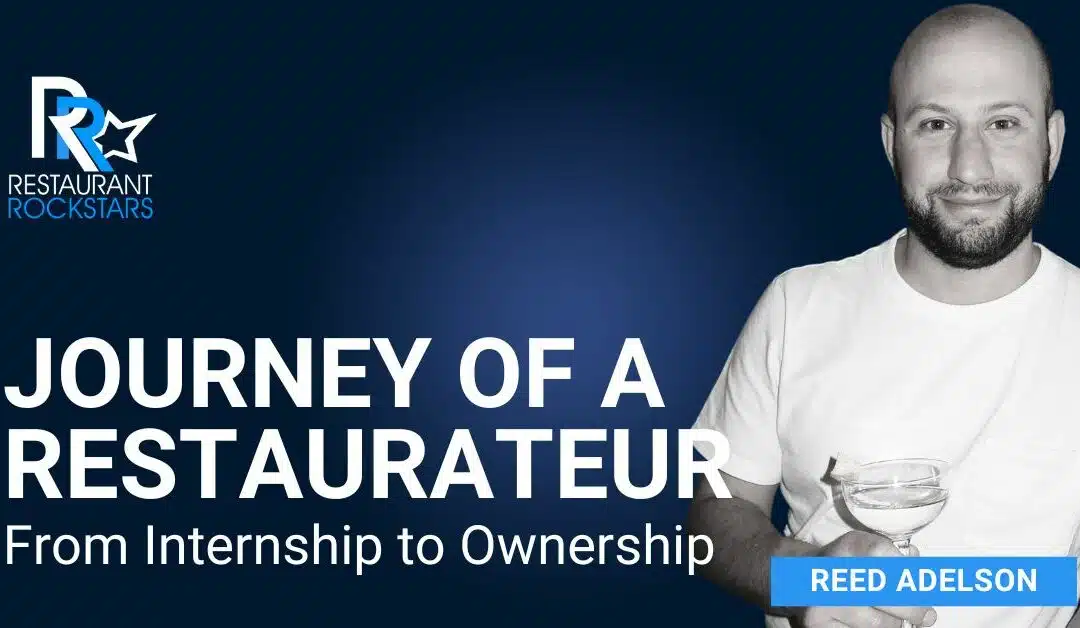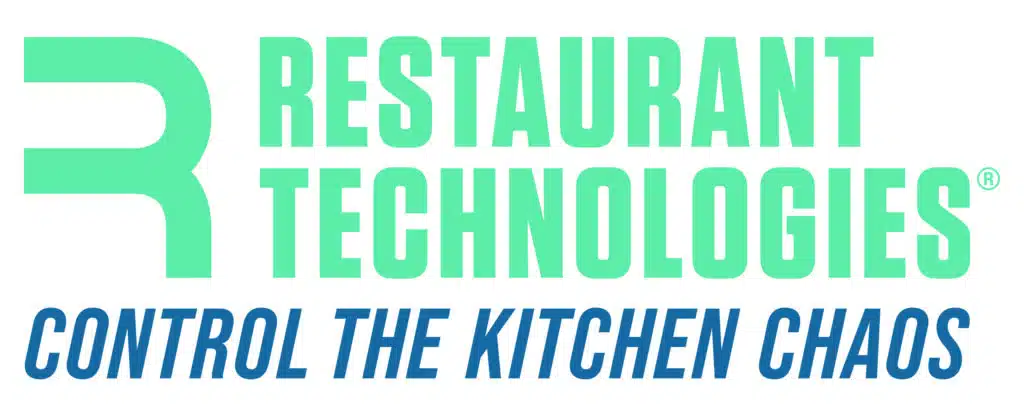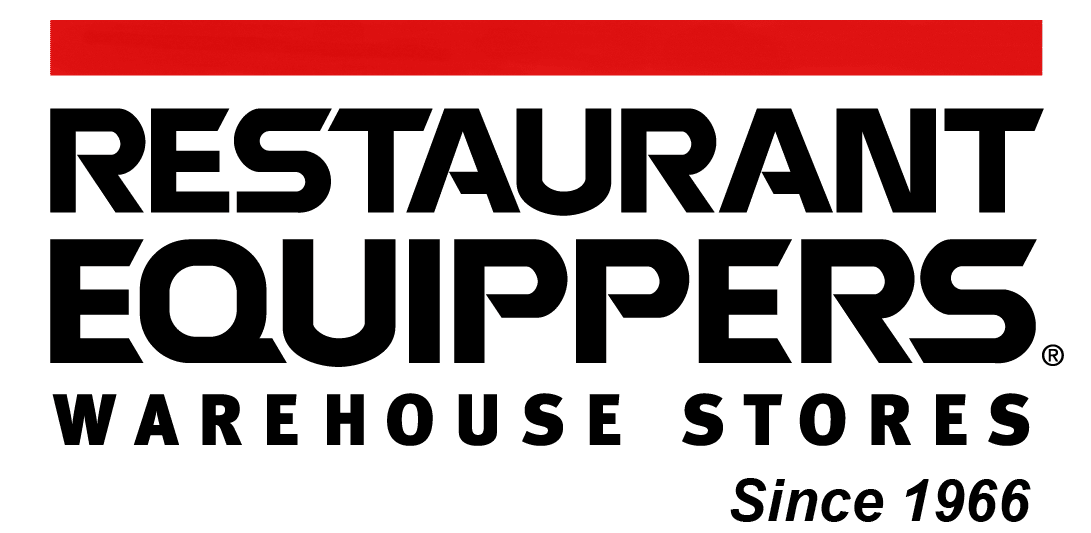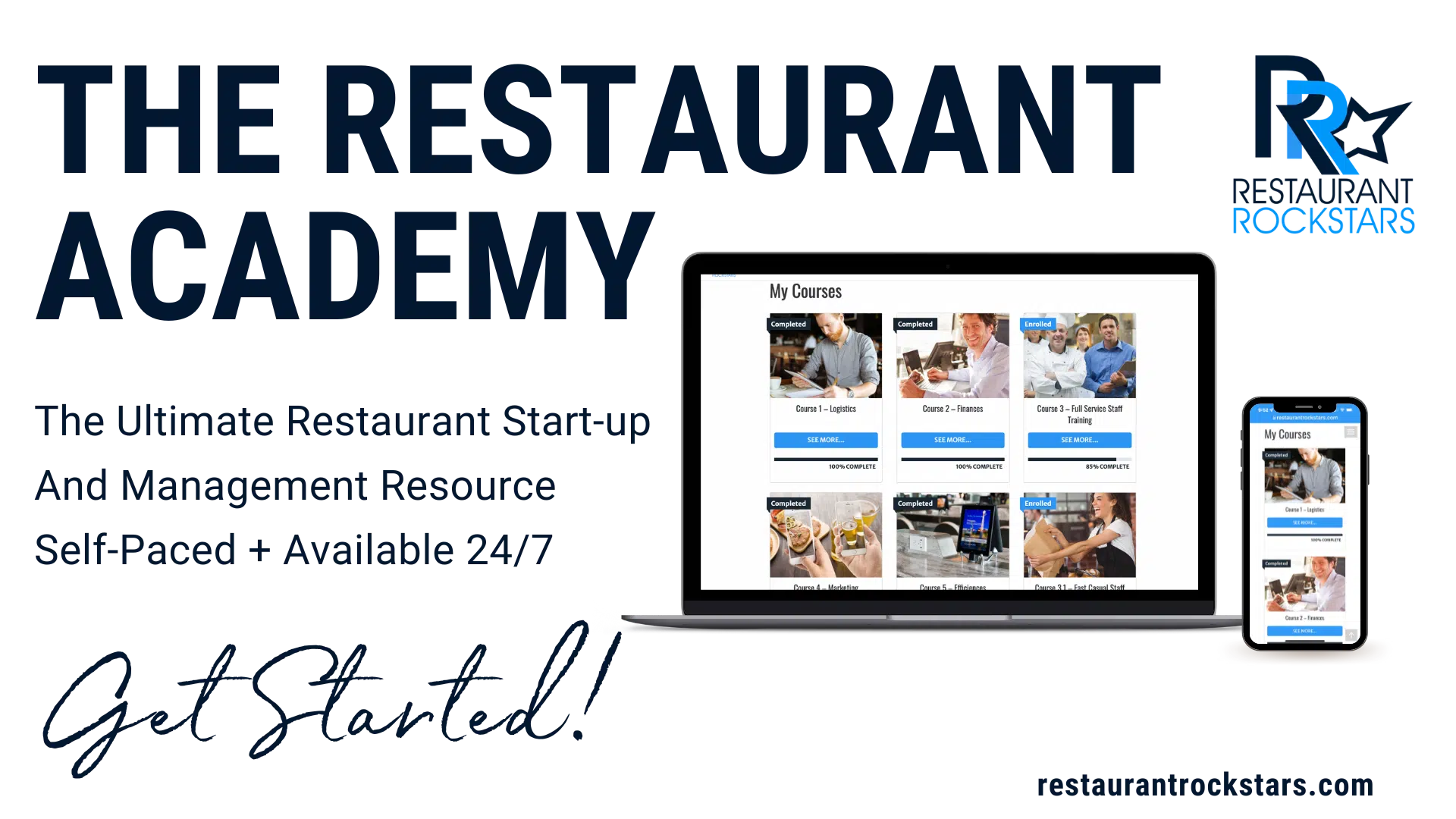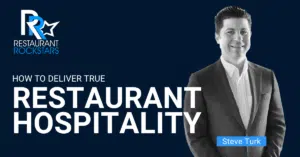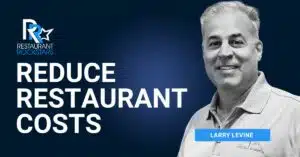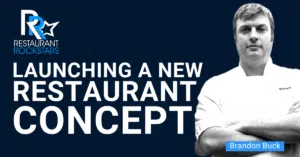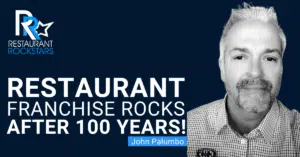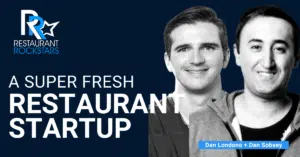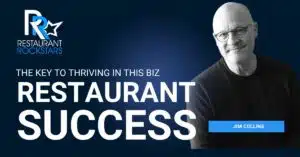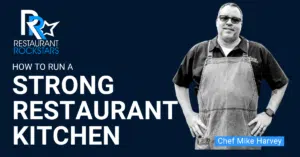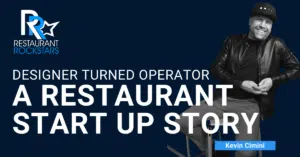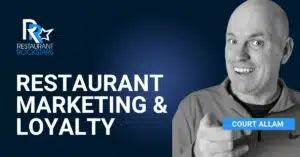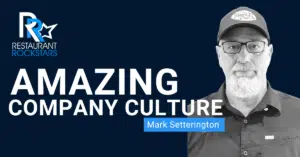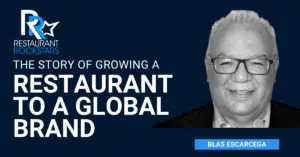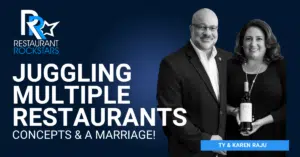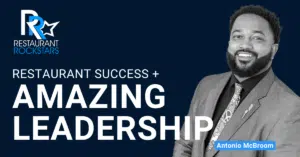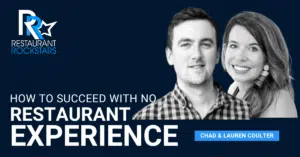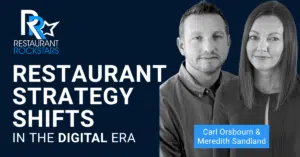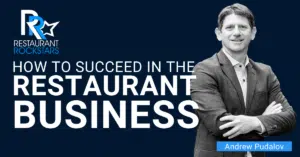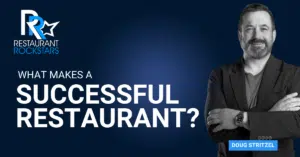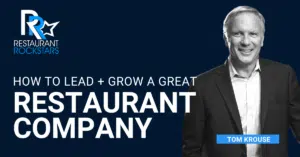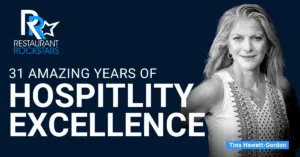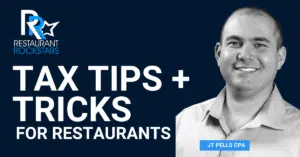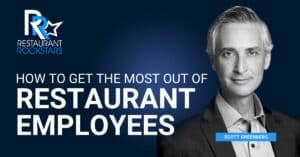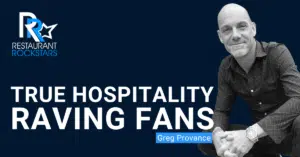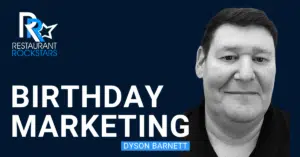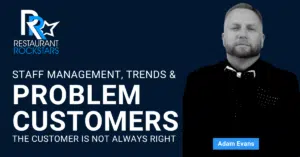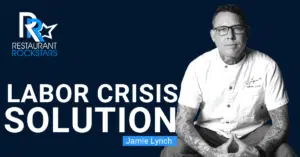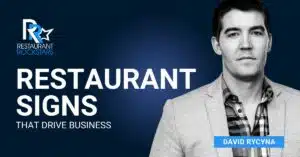Restaurant Rockstars Episode 396
Journey of a Restaurateur: Internship to Ownership
LISTEN HERE OR ON YOUR FAVORITE PODCAST PLAYER
No matter where your restaurant location, competition is stiff.
As a restaurateur you must stand out, offer value and above all, honor and welcome your guests.
Imagine opening a neighborhood restaurant in New York City, competing against dozens of other places, staying relevant and then re-establishing it all over again 8 years later. Talk about challenges. As a restaurateur What would you do first? How would you set your place apart?
In this episode of the Restaurant Rockstars Podcast, I’m speaking with Reed Adelson who’s done just that. He’s a Restaurateur/Founder/ Owner of Virginia’s, a warm and inviting neighborhood restaurant in the East Village.
Listen as Reed tell us his success secrets including:
- His inspiration and founder’s story based on family traditions
- Early start-up challenges in 2015 followed by a rebirth in 2023
- How to compete as a restaurateur with reasonable prices in one of the most expensive restaurant cities in the world
- What he’s done to overcome inflation, labor challenges and other pain points
- Marketing strategy and building loyalty with regulars
- Company culture and maintaining a strong front of house/ back of house dynamic
Virginia’s serves up a warm, inviting ambiance that remains a cherished neighborhood restaurant destination.
And don’t miss our new mini-course – The Restaurant Profit Maximizer – it will show you proven ways to BOOST your restaurant’s bottom line. It cost just $7. Nothing to lose but your shrinking margins. Check it out here https://restaurantrockstars.com/profitmaximizer
Now, go rock YOUR Profits and YOUR Restaurant!
Roger
Connect with our guest:
https://www.virginiasnyc.com/
https://www.instagram.com/virginiasnyc/
https://www.facebook.com/virginiasnyc
Welcome back to the Restaurant Rock Stars podcast. My guest today is Reed Adelson, and he is the founder of Virginia’s in New York City. Now, this episode is a founder’s story. It’s about inspiration. It’s about family tradition. It’s about competing in one of the most competitive restaurant cities anywhere, New York City, of course.
It’s about onboarding. Training your staff, labor challenges and overcoming those, costs, and providing reasonable prices in a very expensive city. It’s about everything marketing. Anything you want to know about running a strong restaurant is in this episode. So don’t miss it. If you haven’t already checked this out, you want to run a strong restaurant too.
You want to be as profitable as you can be. Well, for seven bucks, less than the cost of a fancy coffee or a craft beer. I’ve said this before, head on over to restaurantrockstars.com/profitmaximizer. We have a course that gives you the biggest restaurant needle movers on maximizing your profit.
in your restaurant It’s immediately actionable information that’ll help improve your bottom line. Just seven bucks. Check it out. Now, on with the episode.
You’re tuned in to the Restaurant Rockstars Podcast. Powerful ideas to rock your restaurant. Here’s your host, Roger Beaudoin.
Listen, you need three things, knowing your critical numbers, sales training, and driving new and repeat business. You can now teach your staff 24 7 to run your business and boost sales and profits as if they owned it with our online Restaurant Academy. Right now, the Restaurant Academy is only 59 a month that includes access for you and up to 25 members of your team.
And for a limited time, our new Academy members can get 15 percent off every month using the code podcast15 at checkout. Go to restaurantrockstars.com/joinacademy. Again, that code is podcast15.
Every restaurant needs signage that attracts attention and brings in the customers. Cirrus LED signs bring your business to life and increase customer traffic and sales. Cirrus high resolution LED technology is energy efficient and ensures maximum visibility for your operation. Cirrus signs are versatile and allow easy changing of content and displays.
Cirrus, you can subscribe to pay with low monthly payments and no upfront costs. And now my listeners get the first two months free. Go to try dot cirrus LE d.com/rockstar. That’s try.C-I-R-R-U-S-L-E d.com/rockstar.
Hey everybody, this is the Restaurant Rockstars podcast. So glad to have you here, Reed. How are you?
Glad to be here. Thank you.’
Good to have you on the show. I love talking shop with operators, so I’m very curious, as is my audience, where did it all begin for you? It started here in New York, growing up around restaurants.
My father was a big is a big foodie going out to eat in restaurants in New York always had a, I don’t know if there was ever a passion for food or restaurants or being in the industry, but growing up in New York and, eating at restaurants that, aren’t that are only available in New York and are only in New York and being exposed to that sort of instilled in me an understanding and a basic appreciation for the industry.
I didn’t really have any interest in being in the Restaurants although, when you’re in high school, you don’t really know what the hell you want to do. So my first job was in college in Tampa, Florida. I worked at a steakhouse called Burns Steakhouse which you may or may not have heard of.
It’s known to have the largest wine list in the country.
Oh, no kidding. Okay.
Yeah. So I got a job there really just cause I wanted to learn about, wine to impress girls when I go out to dinner and I needed a job. So it seemed like a logical place to get a job. Got a job there in college working in the wine cellar.
Really just pulling bottles of wine, pouring wines by the glass and learning about wine. The restaurant is so big that they have four or five people just working in the wine cellar at all times. So I never served a guest. I never took an order. I never did anything other than pulling bottles and giving cellar tours and pouring wines by the glass.
And I enjoyed it. I enjoyed being around that culture. I enjoyed wine. I want to learn more about wine and service and said, why don’t I see if I am interested in this as a real career path? So I applied to a bunch of restaurants all around the country really fine dining restaurants, Gordon Ramsey who had a restaurant in New York at that time Danielle Thomas Keller.
Charlie Trotters, I think maybe I applied to Morrishay at the time, and a bunch of other restaurants. Yeah, these are all Lustrous names. Did you end up working for any of those? So the only one that responded was Charlie Trotters because it was a front of house internship. Back of house internships are very common, but unpaid college front of house internships are less common.
So I flew to Chicago, I did a a two day trail, and then they accepted my Internship application. So I did a summer internship there before I graduated college. And I just, I never worked like that in my life. 14 hours a day, six days a week. I just, I threw myself in and that’s an internship. Wow.
That’s full immersion right there. You’re talking about, there’s no half immersion at Charlie Trotter’s. There’s no, you’re either in a really demanding, right? Like it’s an extremely demanding place to be. And if you’re not the best, someone else is. That’s just what I’m assuming based on what I hear.
Very much that was your experience. Okay. Yep. So I liked it and then I I wrote Chef Trotter before I finished college. I said, what? I’m interested in a position. I’m thinking about hospitality school. He calls me and he says, You don’t need to go to hospitality school. I’ll teach you everything you need to know.
Come back here and work for me. After I finished college, I moved to Chicago and started as like a dishwasher, glass polisher, worked my way up into a server. And captain and I was part of the wine team and also involved with special events and Chef Trotter had all these different special events and charity events and anniversary dinners and I was closely involved with all of those and worked there for a couple of years until I got offered a position with Chef Trotter at his restaurant in Las Vegas.
So I moved out to Las Vegas to be the dining room manager at Restaurant Charlie in the Palazzo Tower, the Venetian. And I was there for a little bit over a year. Wow, great experience. Yeah. It was a great experience, but I hated Las Vegas, hated living there. Yep. Very difficult place to live. But definitely a great learning experience.
Wanted to come back to New York came back without a job against everybody’s advice and I got introduced to somebody within Culinary Concepts, which ran some of Jean Georges restaurants at the time, and I was the first manager they hired at the Mark Hotel. So I started room service there, and then when the restaurant opened, I was the assistant general manager, and I was there for several years, which was quite the experience, and then after Jean Georges moved to Le Conde Verde in the Greenwich Hotel in Tribeca.
Where I was assistant general manager for a few years as well, again, tremendous learning experience left there in 2014 to open Virginia’s, my restaurant, in 2015. Which lasted until 2021, closed after New Year’s Eve, and relocated this past March into a new location on 3rd Street. So we’ve been open in the new location on 3rd Street since March.
So you had quite a career, and a lot of it was based on networking. Obviously this industry is huge and it’s small at the same time, but you’ve talked about some experiences that were really extraordinary experiences. You didn’t just work in a restaurant, you worked in some of the best restaurants which is amazing.
So let’s talk about Virginias. And when you decided to come back to New York and you started to put pen to paper ideas in your head, what did you What was, what did you plan on doing? What was the brainchild for that restaurant? And how did you want it to be? And that was in terms of menu, in terms of ambience, in terms of service.
Did it combine all your experiences of what you learned? So you wanted all those things to translate to your restaurant, but it be your own unique stamp. Tell us that whole thing. Yeah, it’s, that’s a hard one to answer, but, I grew up in New York and specifically in Tribeca, I looked at drew Neopore as a big sort of inspiration because he had multiple outlets.
And I always thought that was the coolest thing, and that’s always what I wanted to do. I never wanted to have just one restaurant and wanted to have multiple restaurants and something I strived for. When I got into the industry, it was never just to work at restaurants, it was always to open my own thing, for better or worse.
I never knew how, I never knew quite how difficult it was going to be, but now I know. In opening Virginias, it’s very difficult in New York City. I’m sure, it’s difficult everywhere, anywhere to open a restaurant. But New York City, the real estate is so challenging now more than ever.
If I had a crystal ball or hindsight ten years ago, I would have done some things differently and looked at the numbers of the rent differently because now it’s extremely prohibitive. But at the time, I didn’t, even though I had a lot of experience, I never had owned a restaurant before.
So I didn’t want to start with something where the overhead was such that it was going to make or break me in a month. I understand it completely. Oh yeah. So that was a big requisite in finding the location. In terms of what I was going to do for a restaurant, I always liked a lot of the stuff that Danny Meyer does at Union Square Café in Grand Bishop Tavern, and related to that, I’m not a chef, right?
So I don’t have any sort of culinary background that says, I’m going to cook new Asian cuisine or Mexican cuisine. I don’t have that background the American Bistro model was something that I understood, take on a steak house but a little bit more of a cafe style. So that was something that I always wanted to do.
I always wanted to incorporate raw bar into it, which didn’t happen in the first Virginias, but has happened in this one. So the space kind of dictates what you’re going to do. And I looked at a bunch of spaces, and I looked at this very small, Space on the West Village that we almost signed a lease for.
And when I formed the LLC, it has oyster in the name ’cause we thought it was gonna be an oyster bar. So the name for the LLC still doesn’t Sync with the business, which is very common, but, okay. We eventually found this space in the East Village that the space felt right. You look at a lot of spaces and you walk through and you say, this is.
This is good, but, we’re gonna have to maybe move the kitchen from the front to the back, or we’re gonna have to move the bar from the left to the right, or we’re gonna have to do any number of things to make it work for what you need. And the space that we found was a mess, and it was, it required a lot of cosmetic work and renovations, but we didn’t need to move the hood, we didn’t need to move the Really any plumbing knocked down any walls or anything like that.
Major electrical work. It still took a lot of time and money and effort. But the space worked and it worked for the concept that we wanted, which was a new American restaurant. And that’s why I signed the lease the new space as well, even though I was hesitant to return to the East Village.
I looked at a bunch of spaces and this was the only space that I had seen that felt right for a follow up to Virginia’s. It felt like Virginia’s. It had some of the brick wall that was in the exposed brick that was similar to the old restaurant. The kitchen the layout works. A lot of times you walk into a restaurant in New York City and it just doesn’t feel right.
You walk in and you’re like, it’s just, why is the bar here? Or why is the host stand over there? And why are the bathrooms in the front? I like it, but it just. It doesn’t feel right. It has to feel right when you walk in and you know it. There’s so much to that, Reed. We’re talking about space and, everyone’s heard that crazy cliche about location, which is important, of course, but it’s not always about location because what you just said about making sure the numbers worked and, going into a space that had all the fit ups and had the plumbing and the electrical and the hoods and everything in place was obviously going to save you money And I had a similar experience with my first restaurant.
My initial first couple of spaces we looked at were raw spaces in tremendous locations, but the numbers were never going to work based on the, the lease cost and the cam and all that kind of stuff. Plus the fit ups. We ended up going into a place that had four failed restaurants before we got there, but the infrastructure was there.
There were tables and chairs, there were hoods. There was all the stuff that I didn’t need to buy. And then it became a marketing game and creating a concept that would attract the customer, which we were able to do. Yeah, you’re talking something very similar there. And that’s really fascinating.
While you’re talking about exposed brick walls and vibe, I really the idea of you’ve got menus hanging on the wall from famous restaurants. Tell us about that. And some that I’ve worked for. Okay. Yeah. There’s a menu from Jai George. There’s a menu from Locarno Verde.
There’s a menu from a couple of menus from Charlie Trotter’s. My father collects menus. He’s got more menus than he knows what to do with. I actually have a couple of menus, right? One right here. On this bulletin board next to my desk from pre opening that has everything crossed out and notes on it that I want to frame and put on the wall at Virginia’s.
And then I have a menu my, my stack of papers here from this place in Asheville, North Carolina, a barbecue place that I went to recently and it was their last night of service. I didn’t even realize it. So when I opened the restaurant, he’s, my father suggested you should take some of these menus and put them on the wall.
I said, that’s it’s great. It’s a great idea. It’s the art the art of restaurants, yeah. Yeah, a lot of people don’t realize always that it’s menus because some of them are menu covers and it’s, a hand, I don’t know if you remember the restaurant Chanterelle, you’re in , they used to, everything was hand painted.
So there’s a cool Chanterelle menu, but it’s just this, Drawing of a sea urchin that you may not know is a menu cover. So it’s like a rotating art installation. I haven’t really been able to swap out menus because it’s been so busy since we opened. But I like to swap them out and keep it like a rotating.
That’s cool. It’s funny sometimes when people come in and they don’t get it and they say, can I have the crab legs and the oysters and the the red curry? No. These aren’t our menus on the wall. You can’t order after these. That also begs the question, do you change your menu regularly?
And if so, are any of these menus inspiration? Do you ever look at a menu that you haven’t seen in a while and you go, oh, I should try that dish on the, does it ever work that way? Sure, all the time. I was looking at a menu on the wall the other night from this restaurant in Australia, my father’s menu, old menu, from a Thai restaurant.
I’m like, it’s such a great flavor combination. Sometimes. I don’t know how much the menus on the wall really lead to decisions about what we do on the actual menu. We try to rotate certain items seasonally. The risotto changes seasonally. A few other items change seasonally, but we have staples that don’t really change.
We’re known for our burger, so that never changes. We just put a chicken dish on the menu. A few months ago that we’re talking about changing, but it’s so good and so loved that I don’t want to change it. Yeah, don’t fix what isn’t broken. Yeah, look, we serve brussel sprouts all year round, which took a while for me to Get used to because they’re, they’re not really in season in July, but people love it.
Now it doesn’t really, everybody’s getting Brussels sprouts and asparagus all the time, we’re not serving corn in December, for example. We’ll serve asparagus and peas in the spring and corn and tomatoes in the summer. So those are the sort of hyper local seasonal things. We try to be as seasonal as possible, but, steak fried is steak with maitre d butter and freezing and fries.
That’s not seasonal, but it’s good all year round. And it’s a really good representation of a classic dish that’s going to stay on the menu because it’s timeless. The food looks amazing. I was on your website, and first of all, the website really draws you in because it shows really vibrant
pictures, very professionally taken photos of the food that makes you just want to take it off and eat it and take it right off the screen. The burger was on there. I definitely saw the burger. So really well done job. I’ve always believed that a great restaurant. I can’t claim full credit, but thank you.
It, a great website is something that somebody goes to and it makes you want to visit that restaurant. It gives you the experience of that restaurant before you even walk in the door. So yours definitely does that. So you’re not a chef yourself. So have you had a chef that’s been with you a long time?
It’s like, how’s rotation in the kitchen? Does that happen much turnover and labor challenges and all that? Let’s talk about who’s cooking the food and, how long that lasts, first of all, I know that my, my good friend and colleague, Misty who works with me at Charlie Trotters is going to watch this and she deserves all credit for the website and the photos.
So let me give her a little bit of love and credit for that. Yeah. Misty Wynn, she’s the best. Chef Jake. Our chef has been with us since about June. So we opened with a different chef who was with us for a couple of months. Didn’t really work out. And Jake came on board didn’t really, I’d say 60 percent of the menu.
He didn’t change. The burger, you can’t change the steak frite. We didn’t want to change There’s a few other dishes that stayed as staples, so the initial menu worked, and that wasn’t the issue, it was just some of the logistical issues that sparked the change in chefs so soon after opening.
But Jake’s been very good, it’s a good relationship, I think that when I Opened Virginia’s, I didn’t quite have the same voice or understanding of how the kitchen works and costing and menu breakdown but, after eight or nine years, I’ve figured out what, how to speak the language of chef and what makes sense and what doesn’t make sense and not adding too much.
It’s a small menu. He’s added some really good things like that chicken dish that I mentioned. He definitely, he and I worked to really revamp the brunch menu, which was good, but needed some work. So that was a bigger revamp that has taken off, which is good. Jake’s very good. We’re doing some different sort of pop ups.
We’ve done some beer dinners. We just did a non alcoholic beer dinner a couple of weeks ago with athletic brewing. We’re doing a pop up with Nam Wah. We’re doing like a Lunar New Year sort of duck thing at the end of February. We’re in Restaurant Week right now where we’re doing a Smashburger, which is like all the rage right now.
So it’s just on the Restaurant Week menu, which has been a hit so far early going, but it’s been very popular and seems to be well received. Yeah, it’s going well. Excellent. As long as we’re on the subject, let’s talk about the front of house, back of house dynamic and, leadership and camaraderie and company culture.
Can you describe how that works in your restaurant? Yeah. I think that we have a good back and front relationship. I don’t know that it’s always been that way. I don’t mean, in the new restaurant, but throughout the history of the restaurant, there’s been a couple of different chefs, but for the most part, it’s been good.
I’ve worked in fine dining and, there’s been a little bit, always been some sort of division when I came down to Locanda Verde. That division, that sort of front and back thing, didn’t exist. It was one team. I think that has a lot to do with the management. There was really a strong team.
And a smart team at La Conde Verde, not that there wasn’t Charlie Charters or Jean Georges, it’s just different, I think it also came from having an open kitchen at La Conde Verde, so the chef was right there in the dining room basically and we’ve been fortunate at Virginia’s, both Virginia’s, to have no door on the kitchen.
Really? So it’s not an open kitchen, but there’s not really any door literally and figuratively, but, they’re right there. So you can always, the chef’s not standing behind a barrier. I think that lends itself to some sort of lack of division. And it’s definitely something that we try to cultivate.
So the chef comes to pre shift every day. They know who to talk to. They know who to ask questions. And direct questions too, but you just can’t have that kind of militant kind of culture like you used to have, which is good. You shouldn’t have that. It, Charlie Trotters was, I, I’m close with everybody.
I’m not bad mouthing anybody, but it was really militant, strict, and tough and just pounding your face if you did something wrong. And you just can’t have that, especially not in a more casual setting, because we’re not fine dining. A lot of these guys that work for me are not.
Aspiring to be chefs or restaurateurs. They’re, they’re passionate about food and wine, but they have their other thing going on and you have to be aware of that and create an atmosphere where people want to work, want to come to work, enjoy working. Cause it translates onto the guests as well.
Absolutely. No, that definitely sounds like a strong culture of teamwork and respect. What about onboarding and training? Do you take part in that yourself or do you have a dining room leader perhaps that trains the staff and decides, okay, who gets hired, what’s the onboarding process like, and what’s the training before we let somebody loose, whether they have experience or they don’t have experience, either front or back of house?
Rockstars, when I needed equipment for my former restaurants, I called Restaurant Equippers. Restaurant Equippers has served independent food service operators just like you going on 60 years. You’ll find all the top names and extensive inventory at their huge warehouse stores in Ohio, Michigan, and New Jersey.
You can shop Equippers. com or call their National Order Office at 800 235 3325. Their experienced specialists will help you get the best equipment and supplies and save you money. Thousands of name brand products are available for immediate store pickup or shipment. Just like me, when you need something, you need it now.
Restaurant Equippers will make sure you get the equipment and supplies you need, when you need them, at a price you want to pay. They shop the world to find the best products and value. Give Restaurant Equippers a call for all your equipment and supply needs or check their website, equippers. com.
Rockstars, in my restaurants the fried foods were cranking out of the kitchen, but dealing with the fryer oil and cleaning hoods from all that grease, what a hassle. Not only the high cost, but the mess of changing and recycling oil, scheduling cleanings, you’ve got more important things to run a great restaurant.
Well, that’s where Restaurant Technologies comes in. They serve 40, 000 restaurant and hospitality customers in 41 major markets across the U. S. They handle everything, end to end, from delivering, filtering, monitoring, collecting, and recycling your waste cooking oil. No more mess, safety hazards, workers comp claims, or fried food quality issues.
Plus, this frees up your labor, and the cost, to work on what matters putting out the best food. Restaurant Technologies also eliminates the need for scheduling third party hood cleanings. AutoMist can reduce the risk of fire with automated hood and flue cleaning, hassle free. Restaurant Technologies customers can save 10 15 percent on their insurance premiums and even get bonuses for any new customer referrals.
Control the kitchen chaos with Restaurant Technologies. Go to rti-inc.com or call 866 399 3639 to get started today.
Yeah, we’re so small that it’s very important that we set our team up for success. Yeah. It gets us nowhere to hire and train somebody and then get rid of them. It costs money, it costs time, it costs energy. So we’re all about building people up. And we do have a it’s usually four shifts in the front of house similar in the back of house of training, of paid training, before they go live.
Followed by some quizzes and tests and and that kind of thing. But we always say that the quizzes aren’t really for us as managers. It’s more for you as the server bartender, whomever host to learn where we missed, what we missed during the training. So if we ask you about the Brussels sprouts and you say, Oh, I haven’t seen that, I haven’t tasted it.
Okay. There’s a gap. Let’s taste. Let’s taste that, let’s see it, let’s talk about it, and then you can write it down. So let’s it’s not a pass fail, it’s not a right wrong, it’s you get, did we cover everything, more or less? We hold ourselves accountable even more than the server or line level employee.
Okay, there you go. So let’s talk about, I think you said your founding, the original Virginias was 2015, is that correct? Yes, yeah. And then you closed in 2021? 21, yes. So did the pandemic have anything to do with that or what exactly was your shift? It really didn’t. No, it really didn’t. The lease was up the landlord would not negotiate.
He wouldn’t tell me what was going to happen in terms of the rent or the terms or anything. Really so that coupled with the fact that I really fought with that location for a long time. We were on Abaduc which, in hindsight, we really, I’m very proud of what we did there because it was such a tough location but even towards the end when we were, we started like this and then went like this and then went like way down and then came back up.
And at the end we were doing very well and throughout COVID we actually did well but even still it was just pulling teeth getting people in there Tuesday, Wednesday, Thursday, Friday and Saturday were great, but it was very difficult and then you know, snowstorm was just nothing we would close, Fourth of July was just Deadly.
Those kinds of things were so impactful. We’ve seen an impact here at this location as well. East Village is tougher than West Village, but not nearly to the degree of the old location. Location and lease being up were the two major factors of, So New York City restaurants. There’s a million restaurants in New York City.
You name the culture, you name the cuisine and the concept and you can find it in New York. So it’s very competitive space, obviously. So your location, your current location, is it a neighborhood draw? Do you pull people from different, areas of the city? Is it based on reputation? Is it locals that spread the word?
It’s what’s your marketing strategy and how does it work? We get this question a lot and it’s a combination. It’s definitely people in the neighborhood who come three times a month, get the burger on a Tuesday night and sit at the bar and have a beer and then come back on Friday night with, wife, husband, in laws, parents, and have, chicken and a steak frite and a bottle of, gamay.
So like a little bit of that, and then we have people that come from far and wide that heard about us, again, known for our burger, that heard about the burger, this is the best place for the burger, I got to try it, come in and, oh my god, you have other great things and a beautiful wine list and cocktail program as well, and are wowed by that.
We had somebody the other night that came from the UK and they said they, they flew in and came straight to Virginia’s. Their friends said this is the, the place to go. They came and, it’s a good combination. Terrific. That’s great. And do you monitor your reviews regularly and all the word of mouth and buzz and all the good stuff that’s, that intangible marketing that means so much.
It’s not all good, by the way, the reviews, you get some bad ones sprinkled in there too. The good ones are great, but the bad ones are the ones that, catch your attention. How do you respond to those? Do you do it personally? It depends. Yeah, of course, immediately. I check them every day, every other day.
It’s tough. You can’t win them all. And some people, upset with the table you gave them or, the food was overcooked or undercooked or the drink came out, took too long. It happens, right? It happens to everybody. I, I think that when you have a reputation of being the best anything or the best burger place, or you get any kind of hype, you have high standards and people expect something of it.
So you got to handle it on a case by case basis, but you have to address it. You can’t ignore it. Something that we’ve struggled with a little bit at the restaurant is that people think that because you’re in the East Village that you should be less expensive than somewhere in the West Village.
We still have the same costs, a Surprising, and maybe that’s not the right word, but your prices look really reasonable for New York City restaurants. I think so. But, that’s what I saw. It jumped right out at me. It’s you’re not overcharging and you’re providing a really value and beautiful food at a reasonable price.
And I’m like, wow, that’s amazing. And especially in light of, you’re talking about expenses in New York being over the top and liquor license costs are over the top and overhead and all that kind of stuff. And it’s Probably one of the most, if not the most challenging city to do business in on earth, I would guess.
Yeah. And you started off the podcast by, by saying so kudos to you for making this all work. That’s an incredible challenge and I know from experience what that’s all about. How many seats do you have? It’s about 40 in the dining room plus another dozen at the bar.
In the summertime, we add another 40 ish outside. Oh, so you’re, you do, you open onto the sidewalk, I understand. So you can bring tables out there in warmer months. Yes. And that’s a draw also. It’s people love those sort of neighborhood restaurants where you can walk down the street and there’s outdoor tables and you can now watch the world pass by and eat great food and be part of the ambiance of the place, but still be part of the atmosphere of New York City.
For better or worse. Yeah, exactly. Okay, sure. It goes both ways. But that’s wonderful. That was a big boon in the in the COVID times. Oh, I know it was. Yeah. You go to some of these places and you’re like, I want to eat outside in this part of New York City. But no, we make it nice, we make it beautiful.
That was part of the attraction to this location is 40 feet of unobstructed frontage, so big window presence, no hydrants or anything like that, so we can see all of that on the sidewalk without having to build any quote unquote which is, the rules are being changed for that now as well.
Absolutely. So you mentioned a beer dinner a little while back. Do you do regular tasting events and special events that are they invitation only or you just advertise them, within the restaurant or whatnot and people fill up and you take advance reservations for them? Yeah, we try to do one a month, depending on the month December’s a little bit more difficult, for example, with the holidays and that kind of thing, but we try to do them once a month and try to make, do events that make sense we’re talking about doing an oyster dinner right now, but we’re thinking about doing that in a warmer month, because people might be more attracted to that in a warmer month.
We’re doing a caviar dinner in March. We’re doing this Peking duck pop up in the end of February, right after Valentine’s Day, and then maybe a beer one in April, and then we’ll see after that. It’s good. It’s good for, it’s good for the staff, it’s good for the team, it’s good for, it keeps things fresh.
It’s a good way to drive traffic on a slower day, they’re usually on Tuesdays. It’s it’s been very healthy for us. And it’s all it’s not private. We advertise it internally. We try to get the word out externally in different media outlets as well, but social media but always open to the public.
Right on. Reservations only, first come, first serve, walk ins sometimes. For the pop ups. Just in general, it’s both we keep the bar room for walk ins. So that’s two, four, six, about 10 seats that we keep for walk ins as far as the dining room is concerned we take walk ins obviously, but we fill up usually Thursday, Friday, Saturday but always early and late.
is always, almost always, a great time to come. It’s definitely not as busy early or late. Have you found it hard during the crazy labor crisis that so many restaurants are dealing with? Have you had challenges there or not so much? A little bit of kitchen difficulty at certain points, but for the most point, we’ve been fortunate that people want to work for us.
And, at the current Virginia’s, we have two, maybe three employees that came from the old Virginia’s. At the start we had a couple more at this point everybody that’s on the team has been, if not with us since day one at the new location, they’ve been there for a few months.
Which, is a nice thing to have. Feels good. Seems that we’re doing something right. Exactly. And we already talked about, obviously, you’ve got a loyal following and regulars and that sort of thing, and the people that come in, obviously, three or four times a month, and several times a week in some cases.
I was just curious about your marketing strategy and if you invest in any traditional marketing versus social media and loyal, word of mouth kind of stuff.
So right now we’re using a publicist who we quite like. We’ve gone through a couple of them. We like this person who’s handling our public relations. In terms of marketing, it’s a little bit more internal, things like email blasts. We do we have somebody on our team in house that does most of our social media.
Yeah, between the email marketing, which is done. Internally in the social media. And then we also have a publicist. Excellent. We’re trying, we’re still considering, we’re still in year one. We’ll see how long that strategy remains, but right now we’re trying to keep the forward momentum as much as possible because we still feel like we’re somewhat new.
Let’s go back to, I mentioned that your price is very reasonable. Are you staying on top? Did you have any challenges with inflation? Because obviously menu prices could only be re you could only raise menu prices so many times, but, and still offer the value proposition to the guest, obviously, but the supply shortages and the inflation and the prices of certain things that went through the roof.
How did you adapt to that? Did you have to shrink your menu, take certain things off the menu, shift to different ingredients? What did you do there? A little bit. It really shot up. In the time that we closed, so when we reopened and looking at prices of things from the things that you don’t think about, like mayonnaise or sugar, staple products that, that beef prices went up.
Sure, everybody knows that. Chicken, that kind of stuff. Proteins went up, but when you’re looking at, opening a restaurant in the inventory, you don’t think that the prices on the more staple items like salt went up, and you factor that into your menu costing, it’s difficult. But like you said, you can only raise prices so much.
So our burger is $20 with no fries, and we definitely catch some flack for that sometimes, but it’s not one of our That best.. Dish doesn’t have the best margins as you would think. The beef is very expensive, the cheese is very expensive. We make an onion marmalade in house that takes a lot of labor and time and energy.
A bone marrow mayonnaise, like it’s expensive for us to produce. But how much can you charge for it? We can’t really charge any more than that. We did raise some prices on certain things when we reopened and put a bigger emphasis on the presentation and quality of the cocktails. So they went up from, I think, $16 at the old restaurant to $18.
And Evan Hawkins, who Help put together the cocktail list and who we just opened a new bar with called Romeo’s around the corner. You’re gonna do it, you have to do it right, though. If you’re gonna charge 18, you gotta do it right. And and we did, we bought a nice glassware.
We got, we’re buying, Ice cubes that are specific size and better garnish and better ingredients. We’ve really upped the cocktail program. And the presentation of the food as well. We bought, not that the presentation was not good at the old restaurant, but we’re charging less.
And it was a little bit more pared down. We bought better plateware and logo liners for underneath the burger and taking steps to make it. A little bit, quote, nicer. Yeah. The presentation will have a lot of impact on the guest experience, of course. And it adds value to what people are buying and to the experience.
So I’m definitely in favor of that. So you have a specialty cocktail program as well. Do you have a list of specialty cocktails? And obviously there’s a nice profit there. Yeah the cocktail program is beautiful and something that we’re very proud of continues to evolve and we’re trying to change it.
We have a toddy right now that’s just one on the menu. It’s obviously seasonal but the cocktails have been well received and they’re really good. It’s nice.
I’ve always found that a specialty cocktail list is an initial draw. That’s an icebreaker and people order an interesting cocktail based on a description or ingredients or presentation and all that sort of thing. And then they’ll still order a bottle of wine with dinner. We also opened with beer and wine at the old restaurant.
And it took him a year, it took a year and a half to get upgraded to a liquor license. So that was yeah, that was part of the evolution of that cocktail program of how it started. Whereas here we started here, and haven’t really, it didn’t need to evolve as much as that cocktail program at the old restaurant did.
Yeah, very proud of the cocktails here at this restaurant. It’s nice. Yeah, it’s an evolution. My first restaurant had beer and wine only, soft jazz, music, wood fired pizza, one salad, one pasta, one dessert. It was very simple because sounds like you. It was very nice. I didn’t have any restaurant experience when I first opened my place.
I had business skills, but I’d never run a restaurant before. I’d bartended in college and that was about it. And it was like, keep it simple because we don’t really know what we’re doing or we got to Figure it out along the way. And then that ultimately evolved to this crazy 325 seat place with a full bar and rocking live entertainment three nights a week.
And it’s like where we came from and where we ended up was two different things. I also took a personal interest in wine. I selected all the wines myself and I’m sure you do the same because you’ve got that knowledge and that passion for wine. You probably curate your wine list, is that right?
Yeah. For the most part. We have a gm, Ben who helps and is very good. But the opening wine list, yeah. Are they wines from around the world? Are you special? It is. Yeah. It’s a short wine list. There’s there’s probably 30 references total on the list. So we try to cover all the bases.
We, we’re not, you’re not going to find four Cabernets on the list. Like we try to have different spots. So if the Spanish red comes off, we’re going to replace it with another Spanish red, most likely. So that kind of thing. Yeah, and it’s a bistro. I’m sure you have a Blush or a Rosé on the list, too.
Yeah, of course, a few of them. Some orange wine, some patinade, a good sparkling section pretty well pretty diverse list. How about ports or sherries? Do you find that’s even a thing anymore? Do people have, dessert wines or any of that sort of thing? I wish they did, not as much as I would have liked.
We had a lot of sherry in Port at the Old One when it was just beer and wine only. We have some, not a ton we actually have a nice cocktail right now with some sherry in it. It’s really cool. That’s awesome. Terrific. What’s next, Reed? Are you going to open up another concept or are you going to just stay with Virginia’s?
What does the future look like for you? As mentioned, we just opened yeah, Romeo’s right right around the corner, which is a cocktail bar, which is really Evan’s thing but, a partner in and involved in a little bit which is great and has really picked up some good publicity lately and very proud of another, Difficult project to open as all projects, restaurant projects are, especially in New York.
Yep. So I don’t know what’s next after, after that, that the dust has just settled a little bit there. So that’s taken up a lot of my time over the course of the last couple of months. So now looking to what’s next, I’d like to do Virginia as West Village. I’ve always wanted to do that.
And after that, more bars, I think. More cocktail centric projects. Great. I’d like to do something outside of the city as well. Something where you can try to figure out a way to buy the real estate and not have to deal with New York City landlords. Yeah. That’s so interesting. If you can ever get to that point and control your destiny, because I’ve seen so many restaurants that like you did in your first location, you lose your lease, you’ve built a following in a location, and then if you move Will you be as successful or even more so in the new location?
It’s the landlord always controls the highest and best use of this property. And yeah, that, that is a challenge. So I leased in the beginning and then I only owned property after that. And I found that was a benefit, but it doesn’t work for everyone, but it’s something to keep your eye on, which you’re obviously doing.
I can’t remember who it was that told me that you want to make sure the landlord never makes more than you do a month. And that’s always that’s a lot of times a lot easier said than done. Do you have any spare time? Do you shop the competition? Do you go out to other restaurants in either village and see what’s going on and just stay ahead of what they’re up to?
Two young kids, four and one and a half. oh thats awesome Takes up a lot of my spare time. Yeah, I like to go out quite a bit. I like to go out quite a bit. When we were opening Virginia’s and Romeo’s, Evan and I will go out a decent amount. I feel like I haven’t been out that much since then. Checking out the competition or whatever you want to call it, just R and D’ing it, seeing what’s out there.
Yeah, definitely want to go out as much as possible and see what’s out there and pick up things that you see and you say, Oh, they did this like that. We should do this the same way. Or we should do something like that. We were at Walters in Fort Green, which is a great neighborhood spot. And they did some sort of oyster. Wine, happy hour deal. Dozen oysters and a bottle of wine for however much it was, and I was just about to launch happy hour virginias, and we, that inspired us to do that.
So if you come to virginias at certain hours for happy hour, you can get a bottle of wine and A dozen oysters, I think, for 50 bucks or maybe less, which is a great deal. Yes. And it’s a draw too. What a great pairing and what a good reason to go out. That’s awesome.
Well, Reed, it’s been my pleasure having you on the podcast. We talk restaurants and again, it’s always a passion of mine to speak with other operators and I wish you every bit of success in 2024 and beyond. Pleasure is mine. Thank you so much. That was the Restaurant Rockstars podcast. Thanks so much to our audience for tuning in.
Thanks to our sponsors of this episode. Can’t wait to see y’all next time. Stay tuned and stay well.
Everyone has a birthday, and people celebrate birthdays in restaurants. Birthdays bring larger parties that spend 40 percent more on the guest check. Plus, most birthdays happen in the middle of the week, when you want more business. Are you getting this? Larger parties, larger checks, midweek business traffic?
Is your restaurant capturing the birthday business? If not, don’t let these birthday celebrations go to the competition. The Birthday Club is a done for you soup to nuts service where they handle everything and send you the birthday business. It’s a piece of cake. Go to jointhebirthdayclub.com/birthdayrockstar.
Thanks for listening to the Restaurant Rockstars podcast. For lots of great resources, head over to restaurantrockstars. com. See you next time.
Thank You To Our Sponsors
They handle everything end-to-end from delivering, filtering monitoring, collecting, and recycling your waste cooking oil.
Restaurant Technologies customers save 10-15% on their insurance premiums and even get bonuses for any new customer referrals.
Top equipment brands, extensive inventory, everyday low prices, and 60 years serving independent food service operators.
Cirrus’ high-resolution led technology is energy efficient and ensures maximum visibility for your operation.
Did You Know That 7 out of 10 Adults Dine Out To Celebrate Birthdays?
You Can Easily Capture This Lucrative Business!
Want to become a podcast sponsor?
Please get in touch with Roger at roger@restaurantrockstars.com
